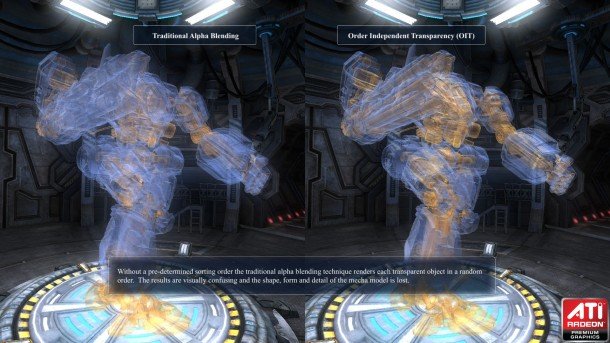AMD say "PC ports of next-generation console titles are likely to struggle" on Intel tech

Intel are heralding their new Haswell processor architecture as a game-changer for gaming ultrabooks and small form factor gaming machines. Their competitors AMD predictably have serious doubts about Intel's ability to compete when it comes to PC gaming.
I spoke with Intel's Richard Huddya few months back about the graphical technology behind their push for Haswell in the gaming market and he was very excited about the progress they were making for PC gamers, but I also put some questions to AMD's Nicolas Thibieroz, Senior Manager of its Gaming Engineering division. I'm sure it's no coincidence I've only just heard back as Haswell is launched. Here's what he said about Intel's latest foray into the world of gaming hardware and what the next generation of consoles, which run on AMD architecture, will mean for PC gamers.
Intel claims that it's “coming well-armed to this particular fight,” in reference to what has historically been a straight graphics technology fight between AMD and Nvidia. Do you see any threat to this status quo from Intel's increasing graphics power moving forwards, or will it likely remain a two-horse race for hardcore PC gamers?
"Building efficient graphics processors is a difficult and complex task involving a large variety of skillsets. AMD has market-leading experience and expertise in this area allowing us to repeatedly deliver power-friendly and high-performance discrete Graphics Processing Units (GPU) and Accelerated Processing Units (APU) for both the PC and console markets.
"We will see a major improvement in console and PC game graphics quality."
Intel has been trying to compete in the integrated graphics space for quite some time but so far has not succeeded in delivering competitive solutions to our AMD APUs. The ultimate demise of the Larrabee project and their current integrated solutions' inability to run many demanding graphics workloads show the difficulties Intel is still facing in trying to compete in the GPU space.
Hardcore PC gamers are demanding people and will always require powerful graphics hardware to run the latest games at their best. 60 fps, large screen resolutions and having the highest graphics options enabled are common requirements for those gamers. The Playstation 4 boasts a powerful semi-custom AMD APU and we will see a major improvement in console and PC game graphics quality as a result. As long as game studios keep pushing the boundaries of realism in real-time 3D graphics, there will always be a market for performance and discrete GPUs."
Intel says traditional GPU architecture needs to fundamentally change in order to compete with the graphics power of Haswell and its new PixelSync API extension. But do you see gaming effects such as order-independent transparency as important enough to really warrant such a shift in design?
Keep up to date with the most important stories and the best deals, as picked by the PC Gamer team.
"AMD presented on real-time concurrent per-pixel linked lists construction at the Game Developer Conference in 2010. We then released the Mecha demo that took advantage of this technique to implement pixel-perfect Order-Independent Transparency (OIT).

Finally we recently worked closely with Crystal Dynamics to integrate TressFX Hair technology into Tomb Raider where each transparent hair fragment is accurately sorted against each other to produce the best-looking and most physically-correct hair implementation seen in a video game to date.
While interesting in itself, functionality such as enabled by “PixelSync” is obviously not a prerequisite to implementing robust and efficient OIT solutions on compute-efficient GPUs – as demonstrated in Tomb Raider.
In fact, serialization of access into read/write buffers (called “Unordered Access Views” in DirectX® 11 jargon) can be done at the API level via a mutex-based solution – AMD already has such functionality running and you can expect the results of this work to be published in the near future.
So to answer your question: game developers will certainly not be relying on “PixelSync” to design the nature of their OIT algorithms."
With AMD making up the heart of the next-gen consoles, can you realistically see developers spending the time and money to code specifically for extensions that wont work with AMD – and by extension next-gen console – hardware?
"In a word: no.
When it comes to high-end gaming, current Intel integrated graphics solutions usually force users to compromise between quality or performance, which is a tough choice to impose on gamers.
The semi-custom APU AMD designed for the PlayStation 4 is built on AMD's 28nm “Jaguar” CPU cores and Radeon graphics which enables 1.84 TFLOPS of performance for leading performance, image quality, tessellation, and efficiency.

In essence, this means the graphics chip that developers are programming for is in a completely different class than what Intel is currently providing on the PC platform, and PC ports of next-generation console titles are likely to struggle to perform acceptably well on Intel-integrated solutions.
In contrast, AMD GPUs and APUs sharing the same or similar architecture will have a much easier time coping with the extra graphics workloads required by this next-generation of titles.
Because of this we do not expect game developers to spend resources on implementing Intel-specific extensions unless they're given strong motivation to do so by Intel."

Dave has been gaming since the days of Zaxxon and Lady Bug on the Colecovision, and code books for the Commodore Vic 20 (Death Race 2000!). He built his first gaming PC at the tender age of 16, and finally finished bug-fixing the Cyrix-based system around a year later. When he dropped it out of the window. He first started writing for Official PlayStation Magazine and Xbox World many decades ago, then moved onto PC Format full-time, then PC Gamer, TechRadar, and T3 among others. Now he's back, writing about the nightmarish graphics card market, CPUs with more cores than sense, gaming laptops hotter than the sun, and SSDs more capacious than a Cybertruck.

